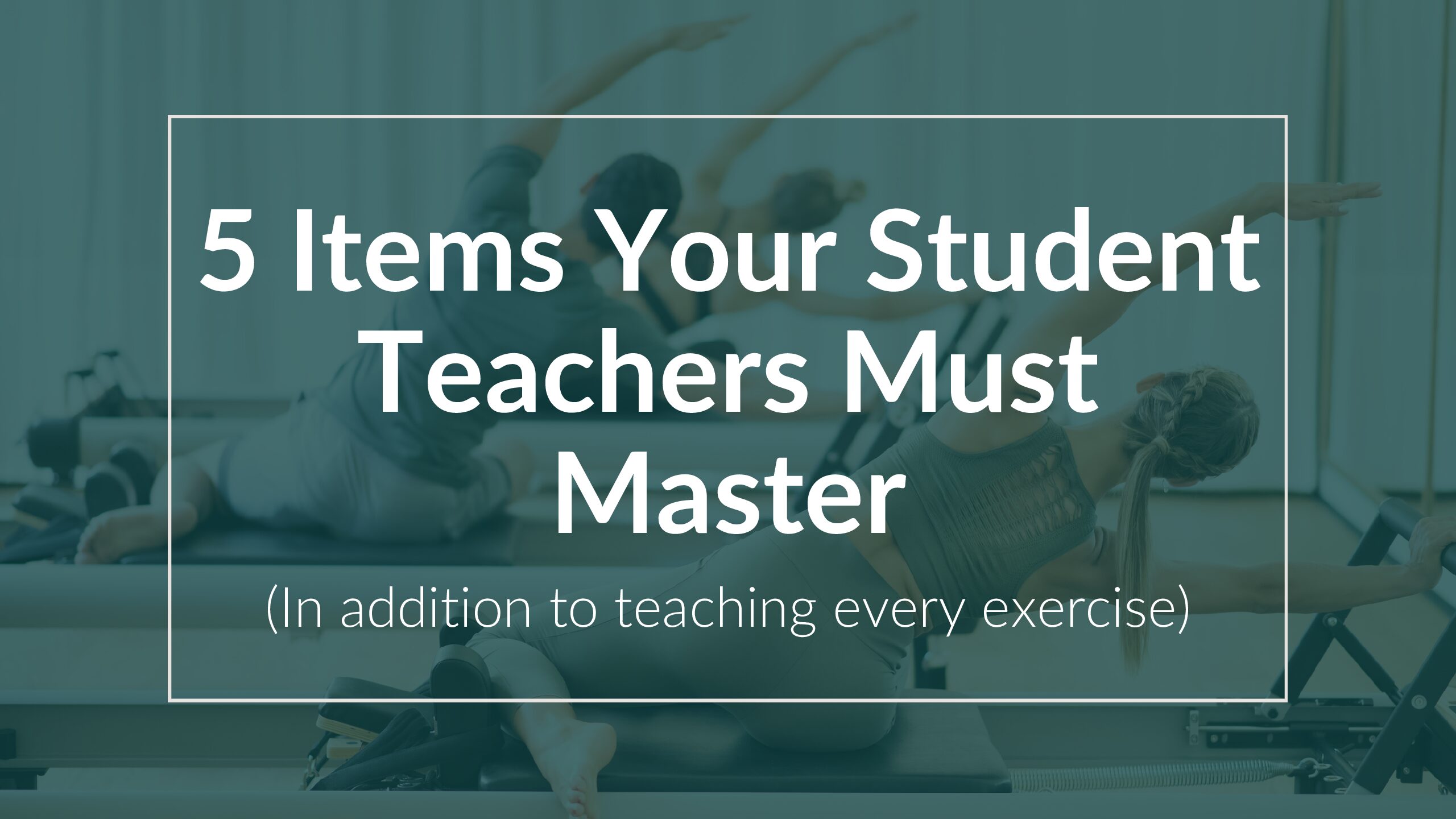While exercises are essential for pilates instructors to master, other skills are also necessary for success.
Read on to learn about the 5 most essential items besides exercises for pilates instructors to master.
1. LESSON PLAN DEVELOPMENT
A lesson plan is the order of the exercises taught in a class that the student teacher designs for a client’s session. This plan ensures that the exercises target the correct muscles and flow together. Using the PEI curriculum exercise choices, it first starts by selecting which of the 7 mats and equipment will be selected for this client. Then, it adds the client’s level of fitness, where they are in the training so far, and if there are any physical issues.
How do you know what apparatuses to use?
Since we are talking about lesson plans that the student teachers are creating, it would depend on which of the 7 apparatuses they are studying. This will allow the student to enrich their knowledge of exercises on a specific apparatus.
What should you take into consideration when creating a lesson plan?
As an instructor, you must consider any physical issues the client may have, the time allotted for the session, and which apparatus is being used.
2. UNDERSTANDING EACH EXERCISE’S PRECAUTIONS
A precaution is a warning that the exercise might need to be skipped or modified based on the client’s health. For example, osteoporosis is OK for extension, but not so much flexion, which would affect the student teacher’s exercise selections.
A contraindication does not do this! PEI rarely uses the word contraindication but does use precaution. Contraindications are definitive statements that are best left to the school director’s determination.
Common Precautions:
Standard precautions that a student teacher will see include ACL knee issues, osteopenia and osteoporosis, stenosis of the spine, plantar fasciitis, pregnancy, glaucoma, and more.
Examples of a precaution for specific exercises.
- ACL Knee Injury: Avoid full extension or flexion of the knee. A doctor’s clearance is recommended before proceeding.
- Teaser on the Pilates Mat.
- Spinal Osteoarthritis: Spine extension can cause pain to a compressed spinal nerve.
- Swan on the Pilates Chair.
- Gastric Reflux: Monitor supine positions and avoid inversions.
- Elephant on the Reformer
- Total Hip Replacement: A doctor’s clearance is necessary. Avoid exercises that cause extreme pressure on the hip joint.
- Monkey on The Trapeze Table.
- Diastasis Recti: This can cause the rectus abdominal muscles to increase separation at the right and left side of the muscle during pregnancy.
- Hundreds on Pilates Mat or Reformer.
3. JOSEPH PILATES’ HISTORY & PHILOSOPHY
Joseph Hubertus Pilates created the Pilates Method. His book “Return to Life Through Contrology” is recognized as the original guide to his healthy philosophy. The exercises that he developed are considered a genius level and the best way to perform exercises that develop the body to the highest level of strength and flexibility. Return to Life Through Contrology is a small book containing less than 40 pages of philosophy and the original Pilates Mat exercises for which he is the model. Student teachers need to study this to understand his philosophy. The book states that following Joe’s basic instructions on breathing, eating, sleeping, and exercising will lead to a much sharper mind and fantastically healthy body.
Return to Life Through Contrology is critical for students to understand Joseph Pilates’s history. Covering the philosophy and technique behind his Pilates method, this book allows students to not only understand Pilates in the context of the modern world but also where it comes from.
4. EXERCISE MUSCLE FOCUS
The skeleton does not move on its own. When muscles contract, they allow the bones to move. Always remember that muscles pull; they do not push. Understanding the muscle focus of the exercise allows us to know where the skeleton is going, which is priceless information when designing lesson plans.
The best ways for student teachers to learn muscle focus for each exercise:
- Study the material in the PEI supportive guide on resources.
- Practice the exercises while discussing which muscles allow the skeleton’s bones to move.
- Review the material with the School Director.
Pilates instructors use muscle focus to develop lesson plans and work with clients from using our Study, Practice, and Review method. This allows the student to become an experienced expert in performing each exercise themselves.
5. UNDERSTANDING MODIFICATIONS
A modification is a well-thought-out way to allow a client to perform the exercise safely. Pilates is a science of movement, and humans are designed in all shapes and models; modifying an exercise might allow the client to do it safely. Student teachers need to understand exercise modifications primarily for safety in exercise selection, as our number one priority is to provide a safe experience for Pilates Practitioners.
A student teacher will learn how to identify times when a modification is necessary with a client through using the PEI teacher training curriculum. PEI includes variations and modifications for every exercise.
By understanding modications, the instructor will understand the importance of increased safety for their client. They also allow recognition from the medical community and the clients that the instructor understands how to modify an exercise properly.
Here’s an example:
The Double Leg Stretch: Many Pilates exercises require the head to be lifted off the ground, which can be problematic for clients with weak neck muscles. A good Pilates teacher factors this into the lesson plan and provides modifications until the neck muscles become stronger.
What do you think? What other skills do you want your Pilates instructors and student teachers to master? Let us know!





